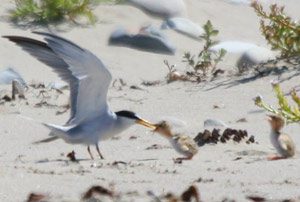While humans can only perceive three types of light—red, green, and blue—birds possess the additional ability to detect ultraviolet (UV) rays. In other words, to birds, we are color blind.
Philipp Heeb from the University of Lausanne (Switzerland) studied the behavior of starlings and blackbirds, particularly how they handle bringing food back to their chicks in the nest. Since they cannot feed all the chicks at once, which ones do they choose to feed first? Numerous studies have indicated that mother birds identify their chicks through their movements or chirping sounds. However, Philipp Heeb discovered another signal that had previously gone unnoticed: the distribution of food varies according to the intensity of UV reflection on the chicks’ bodies.
 |
Many studies have demonstrated that certain bird species locate prey using traces of urine that reflect ultraviolet light (Photo: calliebowdish) |
Since the 1970s, ornithologists have known that most bird species can perceive ultraviolet light, just like many species of insects, spiders, fish, reptiles, and even some mammals (rodents). The retina of birds has a fundamental difference: while humans have only three types of cone cells sensitive to red, green, and blue light, birds have an additional type of cone cell that is sensitive to ultraviolet light. Humans do not see a world the same way birds do.
Previously, there was very little research on this topic, but over the past ten years, experts in avian behavior have had the tools to study ultraviolet vision by analyzing light radiation intensity using spectrometers. The results have been consistently surprising.
Since 1996, Andrew Bennett and Innes Cuthill at the University of Bristol (UK) have demonstrated that the ability to see ultraviolet wavelengths is related to mate selection in some bird species. When they attached UV-reflective bands to male common terns, they found that female terns preferred them over regular males.
Many studies have shown that some bird species detect prey through traces of urine that reflect ultraviolet light. This discovery reveals visual information that was previously unimagined and explains behaviors that can sometimes transfer between species. In the past year, Dutch scientists discovered something intriguing: female blackbirds are more attracted to males with plumage that reflects maximum ultraviolet light. Males also attract more predators, and their survival is likely due to their robust physical condition. Their offspring are more likely to inherit these traits and breed more easily.
Philipp Heeb is interested in the parent-offspring relationship in birds. He observed young starlings: “I noticed that the beak and even the skin of the chicks reflect ultraviolet light. So, I think this could play a role in the recognition by parent birds.” He and his colleagues compared the weight gain of “normal” chicks with those that reflected ultraviolet light. The results were clear: the young starlings coated with a UV-blocking gel gained less weight than those without the gel. In other words, the chicks that were “most purple” received more food from their parents.
The research team suggests that these chicks may be easier for their parents to recognize in the dark nest. They also observed a correlation between UV reflection and the resistance of the chicks. Thus, this spectrum of light becomes a crucial criterion for the survival of the chicks, a visual distinction that we are completely unaware of.


















































